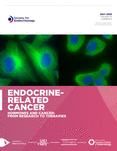BRAF mutation in thyroid cancer
- Division of Endocrinology and Metabolism, Department of Medicine, Johns Hopkins University School of Medicine, 1830 E. Monument St/Suite 333 Baltimore, MD 21287, USA
- (Requests for offprints should be addressed to M Xing; Email: mxing1{at}jhmi.edu)
Abstract
Genetic alteration is the driving force for thyroid tumorigenesis and progression, based upon which novel approaches to the management of thyroid cancer can be developed. A recent important genetic finding in thyroid cancer is the oncogenic T1799A transversion mutation of BRAF (the gene for the B-type Raf kinase, BRAF). Since the initial report of this mutation in thyroid cancer 2 years ago, rapid advancements have been made. BRAF mutation is the most common genetic alteration in thyroid cancer, occurring in about 45% of sporadic papillary thyroid cancers (PTCs), particularly in the relatively aggressive subtypes, such as the tall-cell PTC. This mutation is mutually exclusive with other common genetic alterations, supporting its independent oncogenic role, as demonstrated by transgenic mouse studies that showed BRAF mutation-initiated development of PTC and its transition to anaplastic thyroid cancer. BRAF mutation is mutually exclusive with RET/PTC rearrangement, and also displays a reciprocal age association with this common genetic alteration in thyroid cancer. The T1799A BRAF mutation occurs exclusively in PTC and PTC-derived anaplastic thyroid cancer and is a specific diagnostic marker for this cancer when identified in cytological and histological specimens. This mutation is associated with a poorer clinicopathological outcome and is a novel independent molecular prognostic marker in the risk evaluation of thyroid cancer. Moreover, preclinical and clinical evaluations of the therapeutic value of novel specific mitogen-activated protein kinase pathway inhibitors in thyroid cancer are anticipated. This newly discovered BRAF mutation may prove to have an important impact on thyroid cancer in the clinic.
- © 2005 Society for Endocrinology












